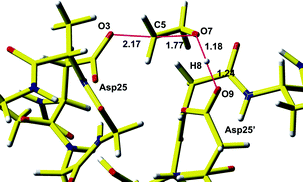Theoretical study on the mechanism of a ring-opening reaction of oxirane by the active-site aspartic dyad of HIV-1 protease†
Abstract
Two possible mechanisms of the irreversible inhibition of HIV-1

* Corresponding authors
a International School for Advanced Studies (SISSA) and Democritos Modeling Center for Research in Atomistic Simulation (INFM), via Beirut 2-4, 34014 Trieste, Italy
b
Institute of Chemistry, Center for Glycomics, Slovak Academy of Sciences, Dúbravska cesta 9, SK-845 38 Bratislava, Slovak Republic
E-mail:
chemkona@savba.sk
Fax: +421-2-59410222
Tel: +421-2-59410203
Two possible mechanisms of the irreversible inhibition of HIV-1

 Please wait while we load your content...
Something went wrong. Try again?
Please wait while we load your content...
Something went wrong. Try again?
J. Kóňa, Org. Biomol. Chem., 2008, 6, 359 DOI: 10.1039/B715828A
To request permission to reproduce material from this article, please go to the Copyright Clearance Center request page.
If you are an author contributing to an RSC publication, you do not need to request permission provided correct acknowledgement is given.
If you are the author of this article, you do not need to request permission to reproduce figures and diagrams provided correct acknowledgement is given. If you want to reproduce the whole article in a third-party publication (excluding your thesis/dissertation for which permission is not required) please go to the Copyright Clearance Center request page.
Read more about how to correctly acknowledge RSC content.
 Fetching data from CrossRef.
Fetching data from CrossRef.
This may take some time to load.
Loading related content
